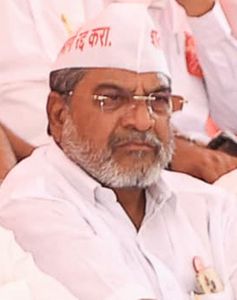FARMERS IN MAHARASHTRA are rising in protest against the state government’s latest express highway project―the six-lane, 810-kilometre Shaktipeeth Expressway, which will cut through 12 districts to connect Nagpur to Goa.
The government touts it as an engineering marvel on par with the Mumbai-Nagpur Samruddhi Expressway. Like Samruddhi, Shaktipeeth, too, is the brainchild of Chief Minister Devendra Fadnavis, who has vigorously defended its necessity. According to him, the expressway will help the Marathwada region to develop like the Mumbai-Pune-Nashik corridor.
“Pune has been Maharashtra’s industrial magnet, but now the focus has started shifting to Chhatrapati Sambhajinagar and Jalna district,” Fadnavis recently told a regional news channel. “When the Shaktipeeth Expressway is completed, it will change Marathwada’s entire economic landscape.”
During the recent budget session, Fadnavis invoked Franklin D. Roosevelt, the former US president who once said America’s wealth was built on its road network. The same will hold true for Maharashtra, he said. “We will talk to everyone and take everyone along,” Fadnavis said.
According to him, the expressway is not just about tourism―it will connect Konkan and southern Maharashtra with central India, spurring widespread growth. “The effort is to build a triangle: Samruddhi Expressway, Shaktipeeth Expressway and the Konkan highway to facilitate faster goods movement. [The triangle] will be our growth engine. We are currently conducting joint measurements, after which land acquisition will begin,” he said.
He acknowledged there was some resistance to the project, especially in Kolhapur and Sangli, but said around 200 farmers from five tehsils in Kolhapur had met him and expressed support. “They gave me a letter of support signed by 1,000 farmers,” he said. “They even showed interest in holding a meeting of affected farmers that could be addressed by me or a senior minister.”
But many farmers, particularly in western Maharashtra, remain firmly opposed―primarily because the expressway would cut through highly fertile farmland. Former MP Raju Shetty and his Swabhimani Shetkari Sanghatana have been leading protests against the project. Shetty told THE WEEK that there was no need for the highway; the government could convert the existing four-lane Nagpur-Ratnagiri national highway to a six-lane one. “The Shaktipeeth project will devastate fertile agricultural land,” he said.
Shetty also raised concerns about compensation. “Farmers on the Samruddhi route got generous packages under the 2013 Land Acquisition Act. But the Uddhav Thackeray government amended it, reverting to an older law. So the farmers will be forced to accept the cheap rates set by the government,” he said.
He said the amendment to the 2013 Act was influenced by corporate interests. According to Shetty, since Modi could not amend the 2013 Act nationally, he allowed states to tweak it. The Uddhav government subsequently amended the Act.
He said the Shaktipeeth project will require 27,000 acres, affecting an estimated 54,000 farmers. “The compensation package for the Samruddhi project was good; farmers could buy land in nearby places after acquisition. But with the Shaktipeeth project, given the amended law, farmers will not even get 40 per cent of what was paid during the Samruddhi project,” said Shetty.
He added that farmers could reconsider their stand if compensation was adequate. But farmers in Kolhapur, Sangli and Solapur would likely still resist. “This is an expressway. Farmers will lose access to parts of their own land―bikes and bullock carts won’t be allowed,” said Shetty. “With only 26 entry-exit points, locals have little use for this road. It will also worsen monsoon flooding in Kolhapur and Sangli because of the overflow from the Almatti dam in Karnataka. Crops will be destroyed if the floods last for seven or eight days.”
Shetty accused the government of promoting the expressway for corrupt purposes. In the stretch from Kolhapur to Yavatmal districts, he said, the expressway would run parallel to the Ratnagiri-Nagpur highway, with the distance between the two roads ranging from just 2km to 20km. “The current highway was designed to earn Rs40 lakh per day, but it is only making Rs8 lakh to Rs10 lakh. So why build another road instead of upgrading the existing one?” he asked.
Shetty also questioned the cost. He said the National Highways Authority of India built roads at Rs35 crore per kilometre. Shaktipeeth’s cost is projected at Rs86,000 crore―Rs107 crore per kilometre. “Where is the extra Rs72 crore per kilometre going?” he asked.
Shetty proposed an alternative model: treating landowners as investors. If private companies are funding the project and will collect tolls, why not treat farmers’ land as capital and give them a share in toll revenue? “We once grew sugarcane―now we will ‘grow’ roads,” he said. Congress leader and former home minister Satej Patil challenged the project’s basic logic: “Why would someone drive from Nagpur to Goa when a flight costs Rs6,000–Rs7,000?”
Patil urged the government to improve existing roads. “Strengthen the district-level roads connecting to the Nagpur–Ratnagiri highway by investing Rs4,000 crore to Rs5,000 crore per road,” he said. “In Kolhapur, 800 acres were willingly given for that highway, and farmers received Rs1,200 crore in compensation. No one protested because the need was genuine. But Shaktipeeth will worsen flooding here, so people do not want it.”
Girish Phonde of the All India Kisan Sabha said villagers were blocking land measurements across districts. “In places like Yavatmal and Wardha, some farmers were initially misled, but now even they are resisting. The elevated highway will not benefit villages along the route. Also, parts of Kolhapur and Sindhudurg lie in eco-sensitive zones, and the planned tunnel under Amboli Ghat will cause huge environmental damage,” he said.
Phonde said they had suggested a high-speed Vande Bharat train between Nagpur and Goa as an alternative. He said neither the chief minister nor the deputy chief minister came to meet farmers when they marched to Mumbai. Only Health Minister Prakash Abitkar was sent, and they refused to meet him.
“Now, we have decided to oppose ministers in all 12 affected districts,” Phonde said.



